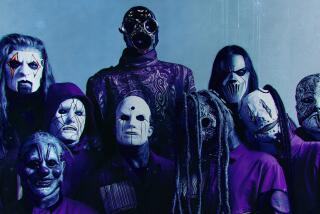Review: Punk, hip-hop and rock are the focus of new photobooks
As with all cultural revolutions, punk and hip-hop were at their most dangerous and fascinating in the beginning. It was also during the earliest moments that some of the best pictures were made of these musical movements as young artists shattered the rules and burned brightly in front of the lens.
Glen E. Friedman mined that territory during the protean years of punk, hip-hop and skateboarding on both coasts. The big, new “My Rules” is not his first book, but it is his most complete and inspired, presenting those scenes with all the color and intensity required.
As he notes in a brief introduction, the once-reviled sounds of punk and hip-hop are now our cultural standard-bearers, influencing new generations of music makers and mainstream commercial society, from Hot Topic to Target. Skating too has become a leading force in the lucrative alternative sports industry, fueling both live competition and million-dollar videogame endorsements.
Friedman’s pictures date to the 1970s and maintain a distinctive forward-leaning vision (including some offhand pictures of the modern hard-core quartet OFF!). He was a sophisticated shooter early on, with a natural inclination toward the most aggressive sounds and experience.
For him, this meant shooting both portraits and onstage action. He not only documented peak moments but also created striking album covers for the likes of the Circle Jerks, Public Enemy and the Beastie Boys.
By 1980, he was spending quality time at music halls and rehearsal rooms with the Dead Kennedys, Minor Threat and Bad Brains. These were not wannabe rock stars on the make but Boho commandos sleeping on floors during no-frills van tours across the U.S., and they blazed a trail for generations that followed.
A South Bay musician who calls himself Spot (born Glen Lockett) was also there at the beginning, as producer and engineer on a series of hugely influential albums by Black Flag, Minutemen, Hüsker Dü and many others on SST Records. Without their example, the 1990s indie rock movement and Nirvana’s crossover tidal wave wouldn’t have been the same. Spot carried a camera during the earliest days of SoCal punk, when few others were paying attention.
His first book of photographs, “Sounds of Two Eyes Opening,” doesn’t document just punk rock, but also the 1970s beach and skate culture that, for many, led straight into it. The connections are both visual and physical: The risk and release of stage-diving was first perfected in the form of skate kids roaring up the walls of empty swimming pools.
The pictures here are raw and personal, mostly in vivid black and white. They date to 1969 but focus mostly on the late 1970s and early 1980s. There are bikinis and roller skates, backyard skate ramps and black eyes. And there are images of an underground music scene being born in graffiti-covered rehearsal rooms, alleys, an abandoned church in Hermosa Beach and even at one notorious Black Flag concert in front of unprepared picnickers at Polliwog Park in Manhattan Beach.
Spot was a musician first, and he shot seriously for only a few years, but many of the pictures are exceptional. Few have been seen outside his immediate circle, and the book includes images rescued from vintage film left undeveloped until 2011. It also comes with a one-sided vinyl single called “Too Wise to Crack,” a hybrid of free-form punk and jazz that captures the vibe of the scene the pictures document so well.
Another kind of rock photographer is Danny Clinch, whose pictures suggest a different commitment to authenticity. A gifted photographer in the organic tradition of Ethan Russell and Jim Marshall, Clinch makes carefully composed but naturalistic images. His first book, “Still Moving,” gathers some of the best examples of what he calls “capturing a moment in music history.”
Clinch is not a photographer with a weakness for clever props or artificial theatrics. His subjects are caught at home, on the road or backstage at the Grammys, and they project something real about their lives and art.
“Still Moving” is beautifully laid out in rich color and black and white, documenting a modern continuum of creativity and personality, from Bob Dylan to Metallica, Johnny Ramone to Jay Z. In one picture, the Black Keys rip down a rural highway in an MG convertible; another has a grinning Willie Nelson lifting up a giant spliff.
The book shows Clinch returning to some of the same subjects again and again, which, Bruce Springsteen suggests in a foreword, is the result of real “trust.”
“Danny and I have written pretty well together over the past decade,” Springsteen notes. The inference, of course, is that there is something similar between making a successful photograph and collaborating on a hit song.
My Rules
Glen E. Friedman
Rizzoli: 324 pages, $55
Sounds of Two Eyes Opening: Southern California Life: Skate/Beach/Punk 1969-1982
Spot
Sinecure: 276 pp., $50
Danny Clinch: Still Moving
Danny Clinch
Abrams: 296 pp., $50
More to Read
Sign up for our Book Club newsletter
Get the latest news, events and more from the Los Angeles Times Book Club, and help us get L.A. reading and talking.
You may occasionally receive promotional content from the Los Angeles Times.







